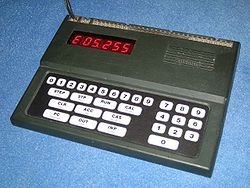Cosmos CP1
The Kosmos CP1 ("Computer Practice") was a learning computer that was manufactured from 1983 by Kosmos-Verlag , known for its experiment kits . It was supposed to expand the range of Kosmos electronics kits to include computer technology.
hardware
An Intel 8049 clocked at 6 MHz and an 8155 are used as the processor, 128 command locations are available as working memory (each with 6 bits for the command and 8 bits for the operand). The entry is made via a membrane keyboard with 30 keys (10 digits, 10 digits in the numeric keypad, 10 function keys). Only a six-digit 7-segment display is installed for the output .
The housing is designed in such a way that it can be connected directly to the base plates of the Kosmos electronics kits that were common at the time.
software
The computer is programmed in a simplified pseudo machine language that is executed by means of the interpreter in the ROM of the built-in microcontroller. Direct programming of the CPU in its natural machine language is not possible. The programming is done by entering the numerical double-digit orders, followed by three-digit operands. A total of 21 commands are available, plus 3 more when using the memory expansion CP3. All numbers (commands, operands, data, addresses) are represented in the decimal system.
equipment
Cassette module CP2
A commercially available MC recorder can be connected to the cassette module via a DIN connection in order to load or save programs. It is controlled via function keys already provided on the main computer.
Memory module CP3
Memory expansion by 128 memory locations to a total of 256, as well as additional IO lines.
Relay module CP4
8 electronic relays can be controlled via the relay module.
Input / output universal interface CP5
The interface contains 8 transistor amplifier stages with 8 light-emitting diodes, which make the effect of the output commands immediately visible, as well as 8 switches, which allow further experiments on data input. The outputs of the transistor amplifier stages are brought out for further applications.
